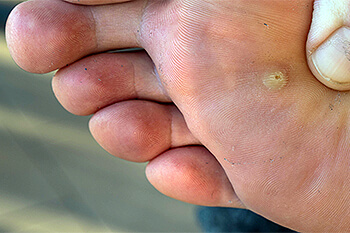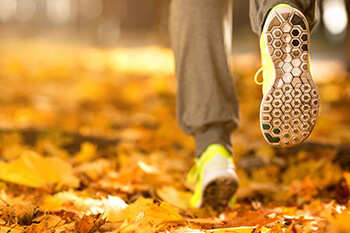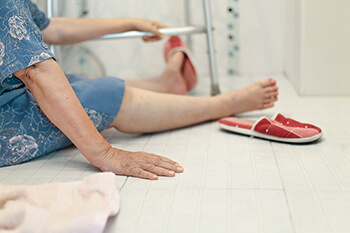Items filtered by date: January 2022
Osteoarthritis in the Feet
 Arthritis is a medical condition that causes the breakdown and eventual loss of cartilage in the joints. This can lead to pain, swelling, stiffness, and difficulty moving the affected joints. Osteoarthritis, which is associated with aging, is the most common type of arthritis and often affects the joints of the feet and ankles. Because of the pain and discomfort caused by osteoarthritis and the effect that it can have on mobility, it is important to seek treatment. Common treatments for arthritis include oral medications to reduce pain and inflammation, wearing orthotics in the shoes to cushion the feet and minimize pain, bracing or immobilizing affected joints, steroid injections directly into the affected joints to reduce inflammation, and physical therapy. If you believe you may have osteoarthritis in the feet, a chiropodist can help you manage this condition.
Arthritis is a medical condition that causes the breakdown and eventual loss of cartilage in the joints. This can lead to pain, swelling, stiffness, and difficulty moving the affected joints. Osteoarthritis, which is associated with aging, is the most common type of arthritis and often affects the joints of the feet and ankles. Because of the pain and discomfort caused by osteoarthritis and the effect that it can have on mobility, it is important to seek treatment. Common treatments for arthritis include oral medications to reduce pain and inflammation, wearing orthotics in the shoes to cushion the feet and minimize pain, bracing or immobilizing affected joints, steroid injections directly into the affected joints to reduce inflammation, and physical therapy. If you believe you may have osteoarthritis in the feet, a chiropodist can help you manage this condition.
Osteoarthritis in the feet or ankles can be a painful and disabling condition that may interfere with your daily activities. If you have arthritis, please consult with one of the chiropodists from Complete Family Footcare & Therapy. Our clinicians will assess your condition and provide you with quality foot and ankle treatment.
What Is Osteoarthritis?
Osteoarthritis is a condition in which the protective layer of cartilage in the joints breaks down over time. This loss of cartilage causes the bones to rub together during movement, leading to pain and inflammation. Osteoarthritis is associated with aging, and often affects the small joints of the feet and ankles.
Symptoms
Symptoms of osteoarthritis include:
Joint pain
Joint stiffness
Swelling in or around the joint
Restricted range of motion
Difficulty walking
Diagnosis
Osteoarthritis can be diagnosed through physical examination. You may also need to have an X-ray taken to assess the extent of the damage caused by arthritis.
Treatment
Treatment for osteoarthritis focuses on reducing symptoms and improving the function of the affected joints. Conservative treatments include oral pain medications, orthotic devices, bracing or immobilizing the affected foot or ankle, steroid injections into the affected joint to reduce inflammation, and physical therapy. In more severe cases, surgery may be necessary.
If you have any questions, please feel free to contact our offices located in . We offer the newest diagnostic and treatment technologies for all your foot care needs
Read more about Arthritic Foot CareCaring for Plantar Warts
 Plantar warts are benign, fleshy growths that occur on the soles of the feet due to a human papillomavirus (HPV) infection. Although generally harmless, they can sometimes grow in areas that bear weight. The pressure of standing or walking may cause these warts to grow inwards, leading to discomfort or pain. Plantar warts can go away on their own, but this may take months or even years. Fortunately, there are many treatments available to speed up the recovery process. Salicylic acid can be applied to the wart to chemically remove the wart over two to three months. Cryotherapy can be used to freeze off warts. Regardless of whether you seek medical treatment or wait for the warts to go away on their own, you should wear comfortable shoes and socks to avoid irritating them. Over-the-counter medications can be taken to reduce pain, and donut-shaped felt or moleskin patches can be worn to relieve pressure on the warts. For more information, please consult with a chiropodist.
Plantar warts are benign, fleshy growths that occur on the soles of the feet due to a human papillomavirus (HPV) infection. Although generally harmless, they can sometimes grow in areas that bear weight. The pressure of standing or walking may cause these warts to grow inwards, leading to discomfort or pain. Plantar warts can go away on their own, but this may take months or even years. Fortunately, there are many treatments available to speed up the recovery process. Salicylic acid can be applied to the wart to chemically remove the wart over two to three months. Cryotherapy can be used to freeze off warts. Regardless of whether you seek medical treatment or wait for the warts to go away on their own, you should wear comfortable shoes and socks to avoid irritating them. Over-the-counter medications can be taken to reduce pain, and donut-shaped felt or moleskin patches can be worn to relieve pressure on the warts. For more information, please consult with a chiropodist.
Plantar warts can be uncomfortable or even painful. If you’re suffering from warts on your feet, please consult with one of the chiropodists from Complete Family Footcare & Therapy. Our clinicians can help you maintain the health of your lower limbs and your mobility.
What Does a Plantar Wart Look Like?
Plantar warts are fleshy growths that generally have a rough, grainy texture. They may look and feel like a callus and are usually small and can grow individually or in clusters. Plantar warts may have small, black dots at their center that are actually tiny blood vessels. Warts interrupt the natural lines of your skin.
Treatment Options
Salicylic acid - A chemical solution applied directly to the wart
Cryotherapy - Freezing the wart off with liquid nitrogen
Minor surgery - Removing the wart through excision
Laser treatment - A concentrated beam of light is used to remove the wart
Wearing comfortable shoes and socks to avoid irritating the wart
Over-the-counter medications for pain relief
Patches to keep pressure off the warts
Plantar warts can go away on their own, but this may take several months to years. If your plantar warts are bothering you, seeking medical treatment is suggested. If you have any questions, please feel free to contact our offices located in . We offer the newest diagnostic and treatment technologies for all your foot care needs.
Read more about Plantar WartsBack-To-School Foot Pain
 The back-to-school season can bring many changes to a child’s life, from new classes and friendships to new, and worsening, foot pain. Children returning to school following a long summer of wearing flip-flops are more likely to experience foot pain. These flimsy summer staples offer little in the way of heel and arch support — something that growing children need. A child’s heel bones continue growing into adolescence. When not given proper cushioning and support, the growth plates of the heel bones can become inflamed, leading to heel pain. Wearing flip-flops also increases the risk of Achilles tendon injuries, pinched nerves, sprains, fractures, warts, and athlete’s foot. If your child is starting off the school year with painful feet, it’s suggested that you take them to see a chiropodist.
The back-to-school season can bring many changes to a child’s life, from new classes and friendships to new, and worsening, foot pain. Children returning to school following a long summer of wearing flip-flops are more likely to experience foot pain. These flimsy summer staples offer little in the way of heel and arch support — something that growing children need. A child’s heel bones continue growing into adolescence. When not given proper cushioning and support, the growth plates of the heel bones can become inflamed, leading to heel pain. Wearing flip-flops also increases the risk of Achilles tendon injuries, pinched nerves, sprains, fractures, warts, and athlete’s foot. If your child is starting off the school year with painful feet, it’s suggested that you take them to see a chiropodist.
Fall is a time of increased outdoor activities, sports, and back-to-school events. It can also be a time of increased foot and ankle problems. For all of your autumn foot care needs, please consult with one of the chiropodists from Complete Family Footcare & Therapy. Our clinicians can help you maintain the health of your lower limbs and your mobility.
Common foot and ankle problems that can arise during the fall season include:
Bunions - Bony growths on the outsides of the big toe joints
Hammertoes - Toe deformity that causes the toe to bend downward at the middle joint
Plantar fasciitis - Inflammation of the ligament that runs along the bottom of the foot
Achilles tendonitis - Inflammation of the tendon that runs along the back of the calf
Sever’s disease - Injury to the growth plates of the heel bones, common in children and teens
Metatarsalgia - General foot pain
Blisters - Skin lesions usually caused by friction over an area of skin
Sesamoiditis - Injury to the tiny, pea-shaped bones located just beneath the big toe
Many of these conditions are associated with increases in physical activity of the change from wearing flimsy summer shoes to more sturdy fall shoes. If you have any questions, please feel free to contact our offices located in . We offer the newest diagnostic and treatment technologies for all your foot care needs.
Read more about FallWhy Live with Pain and Numbness in Your Feet?
Make Small Changes to Prevent Big Falls
 Falls are the leading cause of serious injuries among the elderly. Fortunately, falls can be prevented by making small, meaningful modifications in the home environment and in your lifestyle. These modifications can include reducing clutter around the home, taking special care to make sure that the floor is clear of tripping hazards such as loose wires and cords, movable rugs, and any other obstacles. Make sure that your home is well lit so that you can always see where you’re walking. In the bathrooms, use non-slip mats around the tub or shower. If you have stairs in your home, make sure that you have secure handrails to help go up and down safely. Eating healthy meals, engaging in regular physical activity, wearing comfortable shoes, and using walking aids as needed can all help keep you on your feet. For more tips on how to prevent falls, consult with a chiropodist.
Falls are the leading cause of serious injuries among the elderly. Fortunately, falls can be prevented by making small, meaningful modifications in the home environment and in your lifestyle. These modifications can include reducing clutter around the home, taking special care to make sure that the floor is clear of tripping hazards such as loose wires and cords, movable rugs, and any other obstacles. Make sure that your home is well lit so that you can always see where you’re walking. In the bathrooms, use non-slip mats around the tub or shower. If you have stairs in your home, make sure that you have secure handrails to help go up and down safely. Eating healthy meals, engaging in regular physical activity, wearing comfortable shoes, and using walking aids as needed can all help keep you on your feet. For more tips on how to prevent falls, consult with a chiropodist.
Falls are a major cause of injury among the elderly. To learn more about preventing falls or to get treatment following a foot or ankle injury caused by a fall, please consult with one of the chiropodists from Complete Family Footcare & Therapy. Our clinicians will assess your condition and provide you with quality foot and ankle treatment.
Falling is one of the leading causes of injury among the elderly. It is said that about 50% of falls that result in hospitalization occur in the home. Fortunately, there are steps that you can implement to reduce your risk of falling in the home.
Tips to Prevent Falls at Home:
In the bathroom - Place non-slip mats in the shower or tub, install grab bars near the toilet and bath, and wipe up any moisture or spills as soon as possible.
In the living rooms and bedroom - Remove loose wires, cords, or other objects that may be an obstacle to moving around safely. Make sure that you have good lighting throughout the home so that you can always see where you are going. Get rid of any rugs or mats that are not firmly anchored or that may cause you to trip. When walking around the home, move slowly.
In the kitchen - Store food and supplies in easily accessible areas, store heavy items in lower cupboards, and wipe up any spills immediately to prevent slipping.
On the stairs - Make sure that the stairs are well-lit and have secure handrails. Walk slowly when ascending or descending the stairs.
Outside - Keep walkways well-lit and clear of snow, ice, leaves, and man-made tripping hazards.
Maintaining your overall health, including the health of your feet, can also help to prevent falls. Eat a healthy diet, exercise regularly, and wear well-fitted, comfortable, and supportive shoes. If you have a mobility device, such as a cane, use it while walking.
If you have any questions, please feel free to contact our offices located in . We offer the newest diagnostic and treatment technologies for all your foot care needs.
Read more about Falls Prevention
